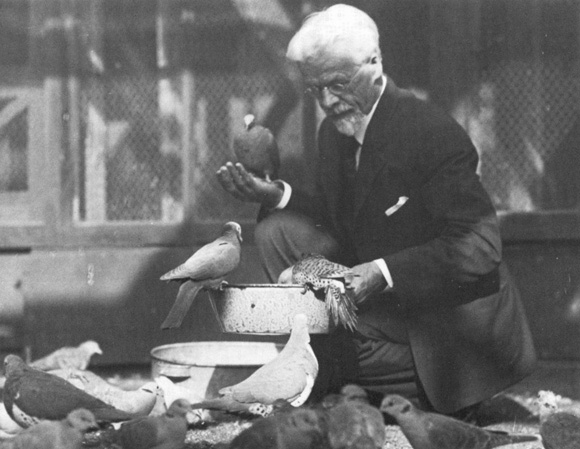National Pigeon Association NewsMangile’s Pigeon Pages
July 1961. p. 24-26
Charles O. Whitman's Flock
 Fifty years ago
(Dec. 6, 1910) death terminated the career of one
of the world's greatest yet least recognized pigeon scientists, Charles
Otis Whitman.
Fifty years ago
(Dec. 6, 1910) death terminated the career of one
of the world's greatest yet least recognized pigeon scientists, Charles
Otis Whitman.This career began in 1392. Picture to yourself an enthusiastic professor with a shock of prematurely white hair, at the age of 50 just appointed to head the Zoology department of the newly created University of Chicago. He was already a famous biologist, author of numerous research studies, particularly on embryology and leeches. He had helped found the highly respected Journal of Morphology and was its editor. He was the director of the Woods Hole Marine Biological Laboratory in Massachusetts, a Mecca for summer research. But now he proposed to take up pigeons.
Why pigeons? One of his students, Wallace Craig, later remembered "He said that he kept pigeons as a boy, and was fascinated by them and watched them by the hour." Here then was a resurgence of a boyhood love. But it was more than that. He felt that there was a fallacy in Darwin's theory of randomness in evolution, and that by making a broader study of many species of pigeons and doves -- a broader study than Darwin's -- he might demonstrate new evolutionary truths, even directional change.
Actually the pigeon work did not get started until 1895. It was not financed by the University, but by Whitman himself and the birds were not kept at the Zoology Laboratory. "His house was surrounded by pigeon cotes, and he always had some birds under observation indoors, so that the cooing of doves was for years a dominant sound in his house. He took care of the birds for the most part himself, though he usually had the assistance of one or two maids. He thus actually lived with his birds constantly and very rarely was absent from them even for a single day. He made observations and kept notes on all aspects of the life and behavior of each species, as well as of such hybrids as he was able to produce. He always had one Japanese artist at work continuously drawing pigeons, and for several years two - Hyashi and Toda." "In the latter part of his life the collection comprised some 550 individuals representing about thirty species."
Every summer from 1895 through 1903, and in 1907, he moved his whole pigeon and dove colony from Chicago to Woods Hole, by train. There, biologists from all over the country, and from other countries, were able to see the birds and acquaint themselves with their biological problems. Professor Alessandro Ghigi of Italy was apparently first fired to study pigeons by observing the exotic species in Whitman's aviaries.
At the University of Chicago he selected and taught only graduate students; that is, those pursuing advanced research. Forty-four of these obtained the doctor of philosophy degree under his direction, many of them to become famous biologists in turn. Seven of them used pigeons and doves for their research: (1) Michael F. Guyer, spermatogenesis; (2) Eugene H. Harper, fertilization of the egg; (3) Mary Blount, early embryology; (4) John T. Patterson, later embryology; (5) Oscar Riddle, feather growth, endocrinology, biochemistry; (6) Wallace Craig, Behavior; (7) George W. Bertelmez, embryology.
In addition to these, Whitman influenced a number of other investigators to pay attention to pigeons, at that period of soon after. These include R. W. Shufeldt in osteology; R. M. Strong, feather structure; T. H. Morgan, heredity (probably Morgan was wore antagonized by Whitman's opinions than inspired); and Harvey A. Carr, Behavior. Also W. C. Allee of the University of Chicago used doves for some of his research on behavior.
Whitman was notable for the loyalty of his students. Almost with out exception in their published reports they demonstrated devotion to his inspiration and guidance. Dr. Frank R. Lillie, one of Whitman's earliest students and his successor as head of the Zoology department at Chicago, wrote a memorial to him (Journal of Morphology, vol. 22, 1911.) He said, "Probably no teacher since Louis Agassiz has exerted so great an influence on young men."
In addition to Whitman's own investigations, he desired to have his students and colleagues make fundamental coordinated additions to pigeon biology. Harper in 1904 and Patterson in 1909 briefly state this grand plan: "This paper is one of a series for the purpose of giving an account of the Natural History of Pigeons." Whitman himself was too busy to publish much. Lillie states "...he could not reconcile himself to publication of more or less fragmentary pieces of work". Further, "He died at the very moment when... he was prepared to publish the results of this extensive and exhaustive investigation."
Whitman's death threw the responsibility for presenting his many unpublished studies to the world onto the shoulders of his scientific friends. It is a great tribute to this remarkable man that his work was not allowed to die with him, but was carried on to completion and publication. Dr. Oscar Riddle was the chief agent in this work, which was published in 1919 by the Carnegie Institution of Washington. It consists of three heavy quarto volumes, full of intensely interesting observations and remarkably life-like illustrations. The many color plates by Hyashi and Toda are both accurate and lovely. Meanwhile Dr. Riddle pushed on into new research fields, using some of Whitman's birds, at the Carnegie Institution's "Station for Experimental Evolution" at cold Spring Harbor, New York.
Some of Whitman's chief conclusions may be stated thus:
(1) That wing color patterns in pigeons and doves have followed an orthogenetic evolution; more specifically, bars are a recent step, having been evolved from checker pattern which in turn was derived from the ancient turtle-dove type of pattern.
(2) That Mendelism as this was then known and mutation as then described by deVries in primroses, were inadequate to explain heredity and evolution in pigeons.
(3) That some conditions of environment, of vigor and health, and of hybridity are capable of modifying sex determination and color variation.
The above conclusions largely failed to impress the biological world. Orthogenesis had a poor scientific reputation already; however, Whitman did not envision purpose in it, but regarded it as a natural and inherent channeling of variation. Mendelism and new studies of mutation were advancing so rapidly at the time that Whitman's negative attitude was ignored. But mature consideration now indicates that he did have a bit of truth in all his points. Modern research discoveries in biology and genetics suggest that he had some prophetic insight.
(4) That behavior is a true and firm branch of biology in which certain motor coordination's acquired during the long history of the species are just as reliable in defining a species, a genus, or order as are any of the bodily structures used in their definitions and identification.
Two years ago (Harvey Lectures, 1957-58) a foremost behaviorist and psychologist Konrad Lorenz, fully credited Whitman's studies, particularly his two Woods Hole lectures in 1899, with the upset of most earlier theories of "instinct" and with providing the more valid evolutionary approach to both animal behavior and psychology.
Here then was a great figure in the history of pigeon biology, a man to whom we owe even more respect than he is generally accorded.
By 1910 when Whitman died, Genetics was only recently named, and Mendelism had not advanced much since 1900. L. J. Cole argued against Whitman's opinions (and Riddle's). Michael Guyer joined Cole at the University of Wisconsin. Whitman was soon forgotten in the avalanche of new data.
